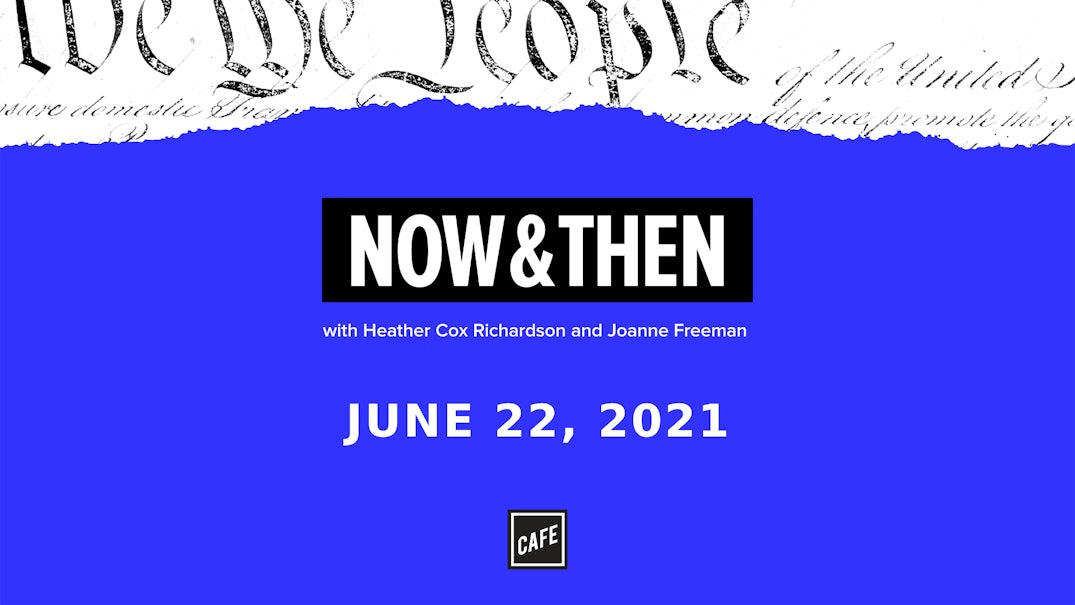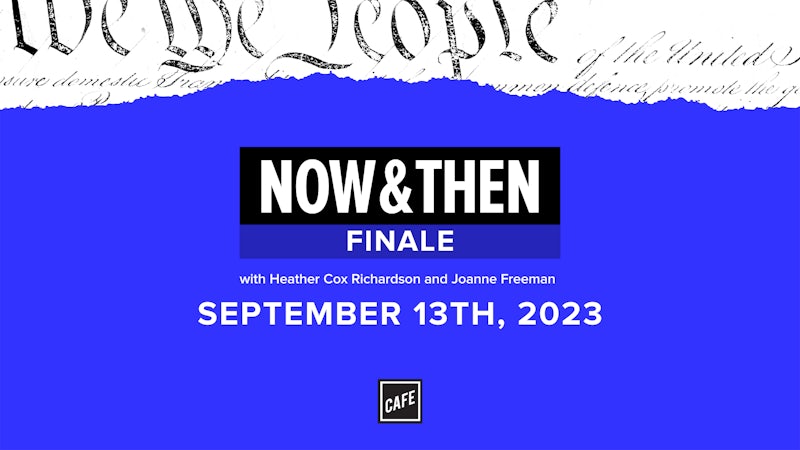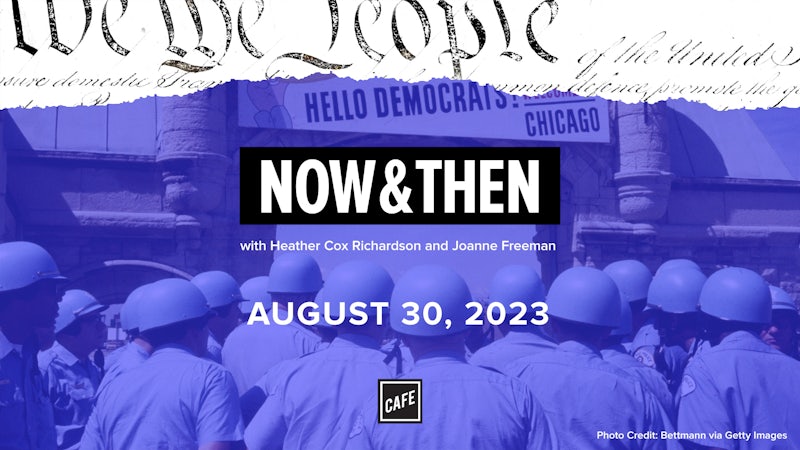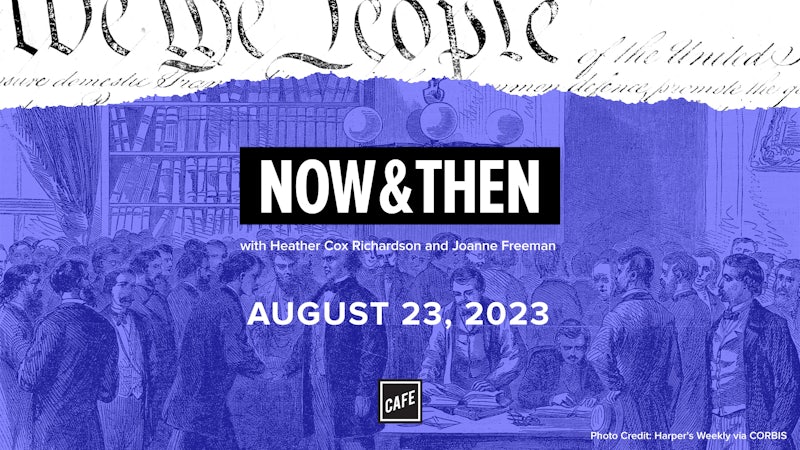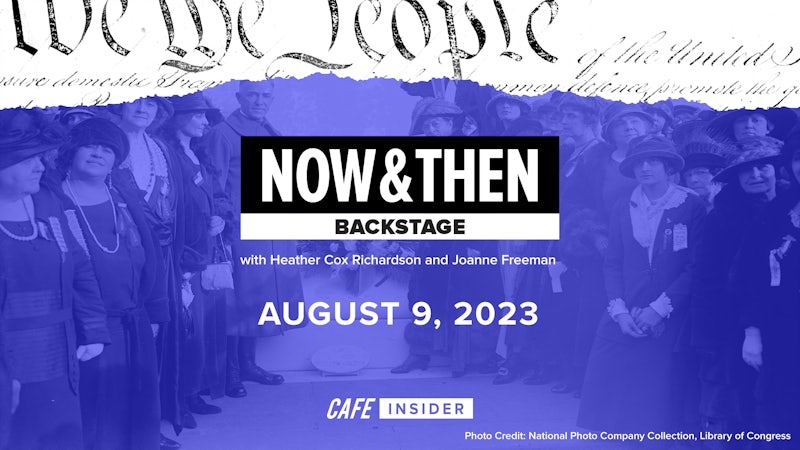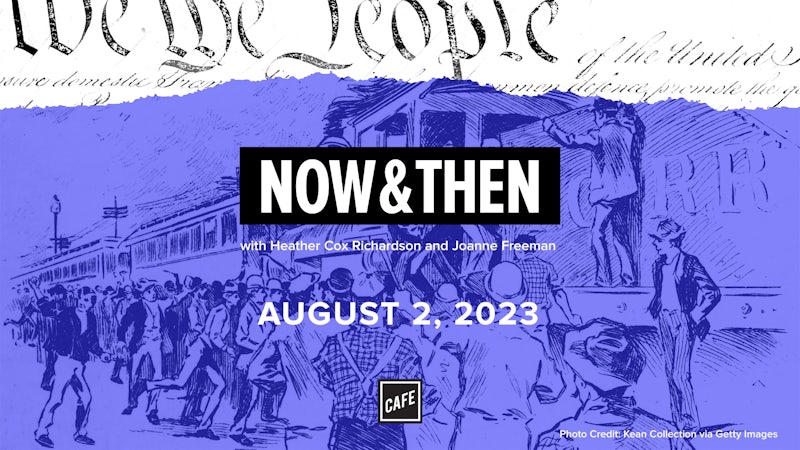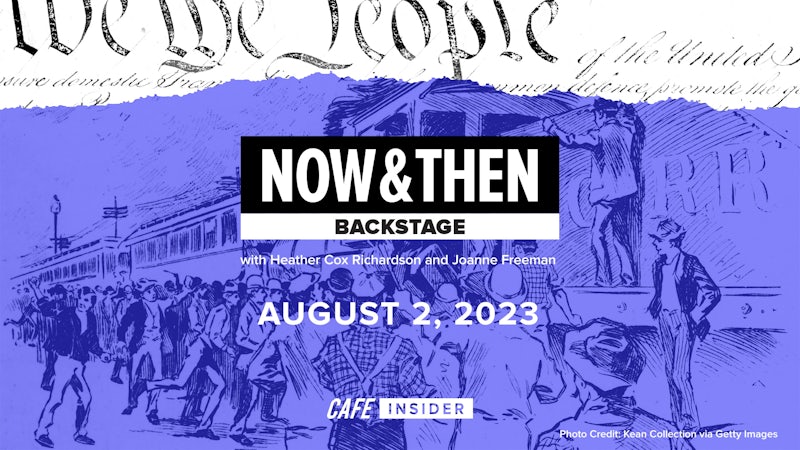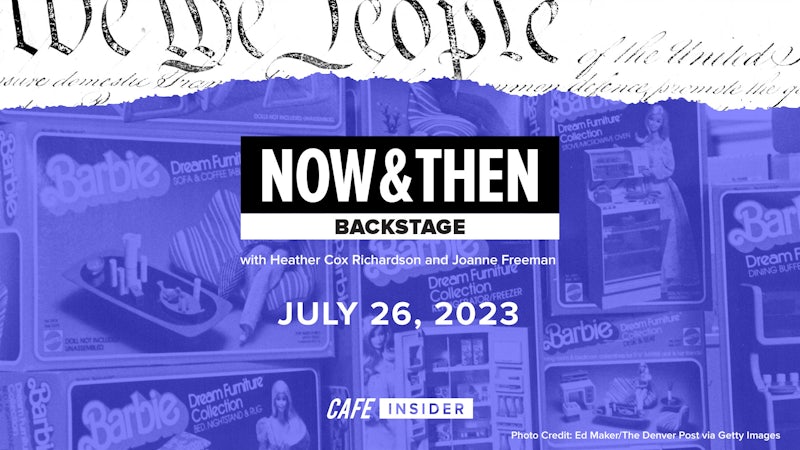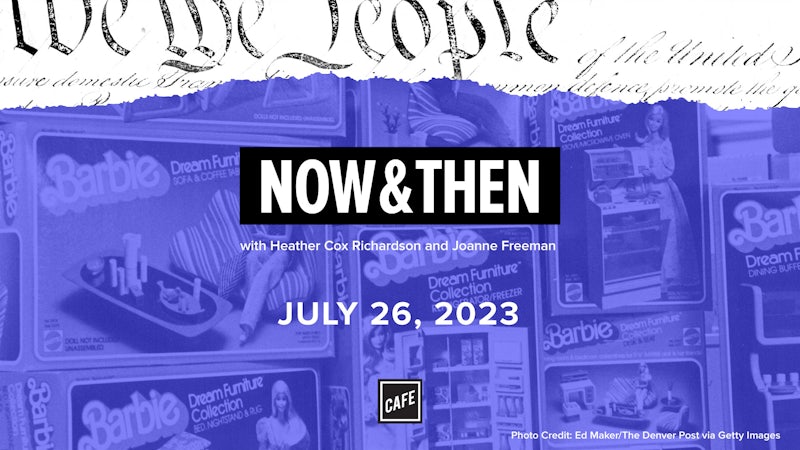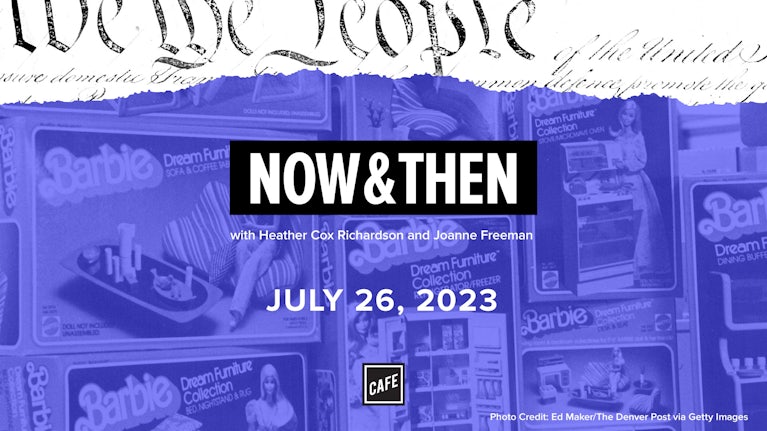Joanne Freeman:
From CAFE and the Vox Media Podcast Network, this is Now & Then. I’m Joanne Freeman.
Heather Cox Richardson:
And I’m Heather Cox Richardson. So this week when we were trying to figure out what to talk about, one of the things that jumped out at us was this FBI threat assessment about QAnon and whether or not it was still a threat to America. And it’s a great two-page assessment of where that particular organization is because on the one hand, it says that a lot of people are probably falling away from the QAnon conspiracy, simply because the person who appears to be the leader, whoever calls themselves Q hasn’t posted in months. And on the other hand, it says that in fact, QAnon is probably getting more dangerous. So we wanted to take a look at what the role might be of QAnon in American politics and in America going forward.
Joanne Freeman:
Now that put us in front of a concept that is not new to this moment, as far as even recent politics is concerned. basically in and out of various moments in the Trump administration, people have referred to some of his followers or even the Republican Party as a cult. And QAnon obviously has put that smack in front of our faces. The question of what is a cult, what do cults do? When can we call something a cult and how can we take that concept and evaluate what’s in front of us? That’s what we want to do today. We want to look at cults in American history and see what that can tell us about where we are at present, particularly regarding QAnon.
Heather Cox Richardson:
So let’s start with what QAnon actually is or was, or might be actually, if you think about it that way, QAnon first appeared on internet message boards. The first post by somebody claiming to be Q was in October, 2017, and gradually a conspiracy theory started to develop in really piecemeal ways, almost like a game. An internet game where you had to piece different things together, but the underlying theme of QAnon was that there was a corrupt cabal of global elites and actors in the deep state. These are all terms that they would have used, who were running an international child, sex trafficking ring that worshiped Satan, and that was engaged in trying to run a coup against former president of the United States.
Heather Cox Richardson:
This would be Donald Trump, of course, while he was an office and he was fighting back against them. And that ultimately there would be a day of reckoning in which these Satan worshiping child pedophiles would be arrested, would be deported, and perhaps even executed. So there was this underlying theme and there were all pieces that people could watch and could engage with to see how this plot was unfolding.
Joanne Freeman:
And just as you just said, Heather, it was a plot where they keep pinning dates on a calendar. Well, on this date, this will happen on this date, this will happen. That there is a master plan and that as you just suggested, the enemy will be vanquished, will be destroyed, whatever that means and we’ve been hearing all kinds of talk about who the enemy is. It’s a pretty wide all embracing enemy. So cult talk is extreme talk, cult talk is terror talk, which is part of why the FBI is tracking some of what QAnon is doing.
Joanne Freeman:
One of the interesting and somewhat frightening aspects of this, which of course we all know is that there are people in government who at least attach themselves to QAnon ideas. And more than that, former president Trump didn’t explicitly embrace ideas from QAnon, but also didn’t explicitly push them away. He was happy that people associated with QAnon liked him. He understood some of what they were doing. He said that what they were doing was good for the country. So he was toying with QAnon enough so that he could remain a part of their ongoing plot.
Speaker 3:
The cause of the theory is this belief that you are secretly saving the world from this Satanic cults of pedophiles and cannibals. Does that sound like something you are behind or…
Donald Trump:
I haven’t heard that, but is that supposed to be a bad thing or a good thing?
Heather Cox Richardson:
There’s some really interesting things about QAnon that jump out. One of them is its emphasis on children and on protecting children. And we’re going to talk something about that today, but one of the things that really interests me is the question of what is it called and where does it come from? And the reason this interests me is because there are many parallels between the cults we’re going to talk about and some of the political organizations that interest me.
Heather Cox Richardson:
So cults usually involve dispossessed people who feel that they have are being marginalized. In order to get back into power, they start to gravitate toward organizations that offer them a special kind of knowledge that only they know you have to have some inside track, some inside information to understand things. Often there’s some kind of ritual to be admitted to a call, not always, but the idea behind belonging to a call and having that special kind of knowledge is that you are the only ones who know the truth. So when the end times come, when there is sometimes an apocalypse, sometimes the return of a religious figure, sometimes at least in this case of some mass arrest, you will be the ones in control again.
Heather Cox Richardson:
And these themes, this idea of taking a dispossessed people and forming them into an organization that has at its heart, the ability to effect a political structure in a country are the exact same things that Eric Hoffer talks about in the 1950s that were an attempt to the rise of a Hitler or a Mussolini. So there’s overlap between the ideas of a cult and ideas about politics. So those are the two things that I really I’m fascinated by with QAnon.
Joanne Freeman:
Directly related to that Heather, one of the ways in which cult behavior or cult thinking explicitly can tie itself to politics and in particular democracy is when you’re in a cult, you’re essentially putting yourself in a permanent winners circle. You have the key, you are the winner, you are the one who will revolutionize or reform or fix things. And by doing that, you’re asserting that your enemy needs to always be in the loser circle. So when you’re in a cult, you’re not talking about democratic dialogue or contest, you’re talking about right and wrong. People who should have power and people who shouldn’t have power. And it’s very obvious to see why there’s a direct kind of a link between authoritarian behavior and some cult behavior.
Heather Cox Richardson:
And yet what’s so interesting about this is that every time in every society you’re going to have people who are dispossessed sometimes way more than others, of course, but they don’t all become dangerous. So we sat down and tried to figure out why some become dangerous and why others do not and we think we tumbled over something.
Joanne Freeman:
Tumbled is good. We wrestled. We wrestled with the idea. One of the things that we found-
Heather Cox Richardson:
In fairness come on, this is really great material.
Joanne Freeman:
… it is really good material. Well, okay. Come on. When we first started talking about this, what did I say in my direct message back to you?
Heather Cox Richardson:
You probably said, “No, Heather, I refuse to do an episode on taxes.”
Joanne Freeman:
Well, I didn’t say that, I was thinking that. No, but what I said, when I think you sent over the word cults, I said, “Ooh, cults.”
Heather Cox Richardson:
That’s actually right.
Joanne Freeman:
Because it was such a fascinating topic. So seemingly irrational and yet to the people in it inherently rational to a degree that some people would follow it to death. And one of the themes that Heather and I found in talking about cults was it seems that in one way or another cults are formed in opposition to government, an unjust government. It’s people stepping forward in one way or another to fix things, to act against a plot, to put themselves in power. But in one way or another cults often define themselves with that kind of opposition. I suppose you used the word a minute ago, Heather, deep state, right? That there’s deep state, bad things that must be defeated.
Heather Cox Richardson:
Yes. And yet they don’t all become dangerous. So let’s go ahead and walk through a bunch of them and see why some ended up being dangerous and why some did not. So there’s absolutely nothing interesting that happens in America before about 1840s. So we’re going to jump right to [crosstalk] Go ahead and take it away with America’s biggest and most famous, at least until now cult.
Joanne Freeman:
I have to say, I wrestled a little bit as to whether I want it to call this a cult or not, but that is where we’ve landed and what I’m talking about and I don’t know how folks are now learning about that in school, but what we’re talking about is the Salem witch trials of 1692. I have a shelf in my office at Yale that has, I don’t know, maybe 15 books relating to this and each one comes forward with a different theory that explains it. Some of them say it was about land and some of them say there was something that they were eating that was making them behave strangely.
Joanne Freeman:
Some of them say it was a gendered thing and some of them say it has to do with native American attacks. There are endless, endless theories. Recent historians that have written about it have said, and actually I found Justin rummaging around to prepare for this two of them who say that actually what caused the Salem witch trials was a perfect storm of factors that all came together. But one of them that really structured the trials is there was a new minister who came to town, Samuel Parris. And he came with some reforms that he was trying to make to the church. And remember in new England, in this time and period, New England, the government and the church are pretty much the same thing.
Joanne Freeman:
So he came in wanting to make changes and established people in the government were not necessarily thrilled with that. So you end up with some of the children of people who are of Parris’s theological ilk, beginning to get seized with fits and people within the church begin to accuse these girls and just generally say that witchcraft is coming to take our church, to break our church and it’s associated with Parris. That witches are attacking these girls. It’s a sign that the government, the church is under attack.
Heather Cox Richardson:
One of the other pieces that I always think is important about this, my bent here is that the Massachusetts Bay Charter had been revoked in 1684. And then the entire government of the colony had been changed a couple of years later. In addition to the religious problems and the 1675 indigenous war going on, there’s also the fact that the government itself has kind of splintered and nobody quite knows if they have a deed to their property or anything else. So you’ve got this problem in society where things are really up in the air. And then you’ve got coming in this new man who also has with him, an enslaved woman from Northeastern South America. She’s an Arawak who has spent time with him in the Caribbean. And she has come to new England with him.
Joanne Freeman:
So she is there as part of the Parris household. Apparently, she played some kind of fortune tilling game with the Parris’ daughter and a number of other girls, and these are the girls who began to get fits and began claiming that someone was attacking them. Now, Tituba was one of the people early on who was taken and interrogated because she was associated with the girls. Obviously, she was a person who was not fully considered a member of that community because of her race. She was really interrogated. At first, she said, “Well, no, there was nothing funny about what was going on.” She didn’t know anything about Satan. She just denied everything truthfully, until finally she was interrogated so forcefully that she said, “Yes. Okay. I’ll admit it. That I signed the devil’s book and that the devil is here and Satan is here and Satan is indeed attacking Salem.”
Heather Cox Richardson:
So then it goes on once she finally says, “Yeah, I’m in league with Satan here and we’re going after the kids.” She doesn’t actually end up getting executed, right?
Joanne Freeman:
No, she does not.
Heather Cox Richardson:
Smart lady.
Joanne Freeman:
She in a way helps opening… Well, exactly. I mean, that’s how she was weighing that situation and that’s how she played that situation in an intelligent way. So no, she is not killed, but she opens the door to this larger idea that, witches are attacking Salem. There actually is a series of trials that are opened, formal trials, again, being held on the part of the government, organizing them.
Heather Cox Richardson:
Well, it goes all the way to the Mass Bay colony, right? It goes up to the governor. He sets up eight judges to go ahead and try the people that are being accused.
Joanne Freeman:
And they do in these trials. They bring the, they call the afflicted girls into the courtroom. People are brought forward and interrogated as to what their connection was with Satan. Again, this was a way of thinking that people were prone to that something funny was happening and the supernatural might be possible. And so things would happen that seemed supernatural. Like someone would walk by someone’s farm and their cows drop the next day and of course, that must be because of witchcraft and the woman who had walked by the field clearly must be a witch. So it’s a community in trial in a sense against itself. But it’s insiders, it’s the government, it’s the people who were there before Samuel Parris came, who are holding this trial and trying to draw lines and decide where the danger’s coming from.
Heather Cox Richardson:
This always fascinates me. You actually have people going about their daily lives terrified that they’re going to get accused by these girls or by their neighbors as the witchcraft hysteria expands of looking at a cow the wrong way, or of crossing a house when a baby expires. And all of a sudden the randomness of life becomes literally a life or death thing. And crucially this poison, if you will, this fear of Satan coming in, of the deep state has been picked up by the actual government and they actually begin to hold trials and when they hold those trials, they end up continuing to execute people and they start with…
Heather Cox Richardson:
I got to confess, I actually went and read the testimony. They started with Bridget Bishop, who had already been accused of witchcraft before and she was a washer woman and on the outskirts of society, but they work their way up into quite high in society and that’s when people start to say, “Hey, wait a minute. Maybe not everybody’s a witch. Go ahead and take the washer woman, but don’t go ahead and take some of the leaders of the town.”
Joanne Freeman:
Now that said, it’s also worth noting that many of the people who were pushing this ahead, the trial and the convictions, and ultimately the executions were leaders of the town. So it’s not only the governor, but it’s a major magistrate in town. It’s also one of the wealthiest men in town who’s actually taking depositions. There are essentially the people who would be considered government office holders in a Puritan church state are the ones pushing this ahead and they’re pushing ahead something that’s rather fuzzy and Heather, as you just said, life and death, they’re executing people.
Joanne Freeman:
Now they do pause in the middle of it because they Gill roughly five people and then they pause a moment to wonder, “Maybe we’re going too far.” They consult with others, but they come right back and go right back to it because again, it feels true to them. The message feels true to them and there doesn’t appear to be any change of circumstances.
Heather Cox Richardson:
Which is just horrifying to think about the idea that whatever started with those girls, and again, I’m making this up as I go along, but sitting there talking in an evening with the enslaved woman in the kitchen suddenly turns into literally the execution of 19 people by hanging and one by pressing to death, which is just truly astonishing.
Joanne Freeman:
And the logic behind that is worth noting, right? The pressing to death is that you’re, you’re literally pressed to death with rocks, but the theory is that will drive you to confess the truth. And of course, in this particular case, the person being crushed told his truth, which was, he didn’t have anything to tell and it crushed him to death.
Heather Cox Richardson:
Mind boggling. And again, the important thing to me here is that you have this idea that there are children at risk in a disordered society. No one knows if they have deeds and what’s going on with the indigenous people and what’s happening religiously with this new guy coming in. They start to listen to the idea that they need to protect these girls and the state gets involved. The government gets involved and they start to kill people. And the end of the day, they try about 200 people. They execute 20 of them.
Heather Cox Richardson:
And one of the things that really jumps out at me is about five years later, one of the guys who have been involved in the trials by this time, he was the governor of the Massachusetts Bay colony and he publicly apologized for the witch hunt and declared a day of fasting, as he said, “So that all God’s people may put away that which have stirred God’s holy jealousy against his land. That he would help us wherein we have done a miss to do so no more.” And especially that whatever mistakes on either hand have fallen into referring to the late tragedy raised among us by Satan and his instruments, through the awful judgment of God. He would humble us therefore, and pardon all the errors and people, the desire to love his name.
Joanne Freeman:
What’s interesting about that to me is that it’s not really an apology. It’s kind of saying whoever did something wrong, we are apologizing for having done that thing, but even at this moment, even as extreme as the witch trials were still, there’s an inability to totally step back and say, “We’re sorry, we did something wrong by accusing these people of witchcraft.” There’s still a degree to which they’re maintaining a middle ground.
Heather Cox Richardson:
Both sizeism.
Joanne Freeman:
They are definitely both sizing. It’s an apology, but it’s a mighty slim apology. Apologizing for death, but not apologizing for the cause of it.
Heather Cox Richardson:
Or looking at the cause of it.
Joanne Freeman:
Right.
Heather Cox Richardson:
So let’s then turn to a different organization that many people thought of as being a cult that had a completely different outcome. There’s a really interesting difference between these two things, because this is going to be the Oneida Community, which is a religious sect that is located in central New York, in the middle of the 19th century. At its peak in the 1870s, it has about 300 members. But again, what’s really interesting about this one. And we had to guess about which one we’re going to pick in the 19th century because there’s so many of them is because in the 19th century with the industrialization and with the westward movement and with people moving into the cities and with the rise of reform throughout the north and with slavery in the south, society has really unsettled. So a lot of people try new ways to engage with government, new ways to engage with each other, and we get a number of perfectionist societies. But the Oneida community really stands out.
Joanne Freeman:
Now, this was an era, as you just suggested, Heather, that it’s not just societies, but it’s utopian societies, right? It’s all of these societies that amidst all the uproar and all kinds of religious sects forming, and the economy is crazy. Amidst all of that, you have people stepping forward and saying, “This isn’t the way society should work. We have a better way and we will show you,” We will create a utopian community that works better. The idea behind many of them is that it will reveal to other people a better way of running certainly, the United States, if not the world.
Heather Cox Richardson:
Well, what’s cool about the United community is that it started by John Humphrey Noyes, who was a preacher actually from Brattleboro, Vermont, not from New York and he believes that Jesus has already returned to earth. He arrived in the year 70 of the current era and those who are already perfect and he’s chosen, those who are already perfect are already living amongst us. So what he does is he tries to create a community of these perfect people. And he believes that because they are perfect, they are outside the world and that means that there should not be, as it says in the Bible, any marriage. So he advances the theory of free love as it was known.
Heather Cox Richardson:
The idea that because all the community is married to each other, if you will, they are not coupled off. He says, “Exclusiveness, jealousy, quarreling have no place there. In a holy community, there is no more reason why sexual intercourse should be restrained by law than why eating and drinking should be.” And there is this little occasion for shame in the one case as in the other. I call a certain woman in my wife. She is yours. She is Christ’s and in him, she is the bride of all saints.
Joanne Freeman:
Now here’s the thing worth noting about him though, is that I think it’s tempting to hear about this, to hear about noise and to dismiss him and the effort as a crackpot endeavor and that he’s some strange outsider. He had some theological training at Yale. So he’s not some outsider. He’s someone who would have been recognized as a respectable person when you dig around and you look at what people said or thought about why he was successful.
Joanne Freeman:
It was some of his established or more establishment looking components that made him attractive, that he did have theological training, that he, as you just suggested, Heather, that he carefully selected the members of this so that he’s picking what he would have considered to be the perfect people that he has a doctrine that makes sense, that he has a whole social image that connects. I will confess that there is at least one work that I checked into that said it did not hurt that he apparently was sexually attractive. I have no sense of whether Noyes was sexually attractive.
Heather Cox Richardson:
I don’t think I’ve ever even seen a picture of him.
Joanne Freeman:
I have not either.
Heather Cox Richardson:
But we’re going to get to Charles Guiteau in just a minute, but there’s something interesting about this community. What people tend to pay attention to is complex marriage, but in fact, there’s something else going on there. What is different about the Oneida Community is two things. First of all, they didn’t really isolate themselves. They went ahead from the beginning and tried to work within the community. They have a very diverse manufacturing part of the community. They produce furniture, they produce bags and slippers and hose and mop handles, and actually even animals steel traps. So they actually invited people from outside to come into their space and they were very curious people, they’d like to have lectures, they’d like to learn, they like to have books around. They weren’t divorced from the real world. They just thought they were above it.
Joanne Freeman:
It’s important to note that, right? Because when you think about cults, what you think about and a objective broad kind of a way are people who are pulling away from society. People who are cutting people off from connection with their loved ones, and this is not being defined against society. It’s actually trying to transform society in, I guess, what you’re describing here, Heather is in a productive way. Now he’s not making war with society and I do think one of the reasons why this utopian society last longer than the others is this precisely that they’re connected with the community and that they actually are creating goods and they have an economy going for themselves. But what’s interesting is that noise did not make war with government, with any government, but he wasn’t sure how he felt about democracy.
Joanne Freeman:
He didn’t think that democracy had value. He thought that really a more monarchical arrangement of things was better because then you could have, I guess, in a perfectionist universe, someone who’s on the top and then people immediately beneath that person. That it was a way of having a controlled utopian society.
Heather Cox Richardson:
Let me guess who was going to be on top.
Joanne Freeman:
Yes, he was going to be on the top, but this is another thing to think about. Often with many cults, there is a person at the top and a cult centers around that person. And then at some point or another, that person leaves and that raises all kinds of interesting questions about what brings people together. Now you mentioned Charles Guiteau.
Heather Cox Richardson:
Yes. Well, so he’s one of the people who’s at Oneida and one of the reasons that most people even know about this community is he is there for about five years and you will all recognize his name, of course, because I’m sure it’s a household word in your families. He’s the man who assassinated James Garfield and he was always mentally troubled. I was actually very unpopular at the Oneida Community, but the fact that they assimilated him for as long as they did for five years was pretty impressive actually, if you think about it and he left later and he sued them for the value of his labor while he was there, that went nowhere.
Heather Cox Richardson:
But the question of what happened to the Oneida Community, I think is really important when we take a look at what’s happening with QAnon now, and in comparison to what happened with the Salem witch trials and when we get to our next cult as well. And that is that in 1879, Noyes ended up leaving the Oneida Community for a number of internal reasons. There was a fight over succession, whether he could appoint his son to take over his place for example, but he was concerned that he was in trouble with the law because of statutory rape, for example.
Heather Cox Richardson:
So he actually goes into exile in Canada and the community very quickly abandons most of its religious principles and pivots to becoming a manufacturing concern. So in a way he’s connected with the government in the sense that the government threatens him so that he feels like he needs to skip town, but when he’s gone, the community is well enough established in the larger community that rather than looking inward and feeling like the ground has been ripped out from under them, they pivot incredibly successfully.
Joanne Freeman:
So eventually, the Oneida Community transforms itself exclusively into manufacturing silverware, and flatware, which is probably what, if any of the word Oneida, that’s probably how you know it. And ultimately it was acquired by someone else and they are still producing silverware. Scholars have done some research on what people think of cults, particularly what Americans think of cults. And one of the things that they seize on is the word cult has no positive meaning to it. That it’s always negative. That it’s always an attack. What we’re looking at here in a way is something that you could define as a cult.
Joanne Freeman:
You might not want to be a part of this cult, but it wasn’t something that was evil and separating people from their loved ones and stealing money from them. A utopian cult of sorts, you could still describe it as a cult by the definition of one, but it’s a different kind of an enterprise. So it really suggests that we need to think about what cults are, why we call them that and what that suggests about what they’re doing and how they’re doing it.
Heather Cox Richardson:
And how that connects to the government, because that relationship really matters there. And that brings us to the final one we wanted to talk about and that, and I’m going to insert the words, of course, here is Jonestown. In America, you really can’t talk about cults without talking about what happened in Guyana in 1978, in Jonestown, Guyana in November of 1978, when what was billed as a utopian community, in fact, engaged in a murder suicide that took 912 lives, largely people from the African-American community.
Joanne Freeman:
Now, Jim Jones is an interesting person. He was basically an anti-segregationist. He wanted to create a rainbow people. He wanted to bring together people of all races. So he was someone who had a vision of society that blended in well with the rising civil rights movement of the 1960s and the 1970s. It makes sense that he came at that time. So Jones creates the people’s temple. It’s based in San Francisco. He wants it to be a rainbow community to blend races together and a lot of the people who he’s pulling from and who are attracted to this movement are people who feel dispossessed in some way. People who need and want someone to reach out to, to offer some sense of support. The community in what ends up being Jonestown in Guyana has a mix of people, but it has a large population of black people there, who he pulled and attracted from in San Francisco.
Joanne Freeman:
Eventually, he and the people’s temple begin to feel put upon and pressed enough in San Francisco that they decide they’re going to create their own magical space in Guyana. There are accounts of some people went ahead to build it and others were constantly told about this wonderful place in the jungle, where they were going to be free to do what they want. And it would be an ideal society. So they do indeed go down to Guyana, but not surprisingly they’re in Guyana and there are family members back home who are alarmed at the fact that some of their family members have joined the people’s temple have vanished. The people’s temple was largely funding itself with the social security payments of roughly 200 foster children that were living there in Guyana, as well as a number of other payments. Those alone from those foster children, that brought in roughly $37,000 a month.
Joanne Freeman:
So it’s supporting itself based on these outside funds, but as in San Francisco and in a sense, even worse in this case, you get family members who are concerned about the fact that their family members have vanished. They’ve gone to Guyana. They’re not sure what’s going on. They’re not really able to contact them. Jones was not really open to that kind of contact. Certainly not open at all to people leaving in any way. So Americans begin to go to their members of Congress and ask for some intervention. There are Americans in Guyana who maybe are being held there against their will, and there needs to be some response.
Heather Cox Richardson:
And even before they went down to Guyana, there were starting to be rumors of physical punishments of people being held against their will in San Francisco. So when they further move down to Guyana, people are really concerned. And finally, even though Jim Jones and the people’s temple have been powerful in San Francisco politics in the past, California representative, Leo Ryan asks Congress for authorization to go down and see what’s going on. And he says, “Some 1,400 Americans were living in Guyana,” he said under somewhat bizarre conditions. And he said he had conflicting information about whether they were being held there against their will.
Heather Cox Richardson:
So he proposes a trip down to Jonestown to see for himself going on. Meanwhile, the leader, Jim Jones looks at the idea that this Congressman wants to come investigate him and he uses that American term, thanks to the Salem witch trials of things, being a witch hunt. He says, “You are on a witch hunt against me.” And that there is a conspiracy against his church. Nonetheless, in November, 1978, Ryan goes ahead and puts together a fact-finding trip down to Guyana with an aid with his aide, Jackie spear, and a group of journalists. On November 17th Jones goes ahead and welcomes them to Jonestown, gives them a fancy dinner and tries to convince them that everything is on the up and up. But some residents are secretly asking Ryan’s help to get out of Jonestown.
Joanne Freeman:
Let me add though, that Ryan is savvy about what he’s doing and apparently, I mean, he talks to a lot of the people who are living there and says, “I understand that for many of you, this is the best thing that has ever happened to you in your life.” And people applaud him. So he doesn’t sweep in like an avenging angel to somehow declare them evil and take people away. He actually is on a seemingly friendly fact-finding mission. But as you just said, Heather, some people step forward and they want to leave with him when he leaves.
Heather Cox Richardson:
They pass him notes and they whisper to them and a lot of people, way more people than they have space for asked to leave. So they have to ask for another plane to come in and help get them out of Guyana. Well, when that happens is they go to leave on the airstrip out of the jungle. Jones actually sends gunmen to ambush them and they start to shoot them there on the tarmac. So Congressman Ryan, a photographer from the San Francisco examiner and a cameraman from NBC were all killed. The aide, Jackie Speier actually was shot five times and she laid on the tarmac for 22 hours before she was rescued.
Heather Cox Richardson:
The gunman seemed actually to focus on taking out the newspaper reporters that were with the group. So while that’s going on, while they are shooting at the people on the tarmac Jones ordered his followers to commit mass murder and mass suicide by drinking… actually it’s not, Kool-Aid everybody thinks it’s drinking that people drink but it’s actually a knockoff called Flavor Aid that’s been laced with cyanide and barbiturates.
Joanne Freeman:
But here’s the thing about that nightmare scenario. And that is he actually does broadcast one last message. They had been practicing. It’s worth adding that they had been practicing in their community suicide murder drills of sorts in case someday that they would need it. And now, obviously that moment has come. He broadcasts one final message and says, apparently this, “I’ve tried my best to give you a good life. In spite of all that, I’ve tried a handful of our people with their lies have made our life impossible. There’s no way detach ourselves from what happened today.” And with that message, he then gives the order for people to drink this laced non Kool-Aid product.
Joanne Freeman:
Now horrifically, the first thing that they do is feed it to the children and the babies, which I can’t even imagine. I want to come back at the end, Heather, to this idea about children and babies, because it’s such a continuing thread. I think for some particular reasons, but then the rest of the community takes this laced drink.
Heather Cox Richardson:
What jumps out about Jones town for our discussion about the moment today is that unlike the Oneida Community, where the government really didn’t play a role except to threaten a noise from the outside, in this case, Jim Jones felt that his enterprise was under attack from the US government and he forces it to the extreme. He forces it into murder and into suicide. What we have here is three very different ways of the way cults play out through time. In some ways, really, depending on the way that they interface with the government.
Heather Cox Richardson:
In the case of the Salem witch trials, the people going after their enemies, co-op the government. In the case of the Oneida Community, the government really doesn’t get involved and the people stay very much part of society and go back and forth through it and eventually when noise disappears, go ahead and become a manufacturing concern. And then we have the horror of Jonestown where a few true believers go deeper and deeper and deeper literally into the jungle, into their own world until they feel that their only way to continue to have their dream is to commit the ultimately unthinkable act of murder and suicide.
Joanne Freeman:
Again, that’s such a dramatic example of one of the points we made towards the beginning of our conversation today, which is that very often, if you’re in a cult, you believe that you are right, you are righteous, you are intending for the good and that anyone who is opposed to you is evil, is out to no good, must be vanquished, must be defeated and potentially must be executed. So what we just saw in Jonestown is what happens when you feel that you’re not going to win that battle. The solution to that is well, then we’re going out as a group.
Heather Cox Richardson:
And now to link that forward to the present, we’re looking at a cult type movement active in this moment in America, that is at least in some ways connected to the government. And according to the FBI report, in some ways people are falling away from it and it’s not clear at all where we’re going to end up. But I do think that there’s a very, very important moment on January 6th. When that happened, remember I mentioned Jackie Speier, she is now a Congresswoman from California and she was in the Capitol building when the insurrectionists tried to take it over. She was one of the people hiding in there and she later told a reporter that it brought back flashbacks. She said…
Jackie Speier:
Well, I certainly never thought that I would be potentially the victim of gun violence in the Capitol of the United States. I was hiding crouched down with many of my colleagues in the gallery of the Capitol. The protestors, the terrorists were pounding on the door, trying to get into the chamber and then I heard one shot. And when I heard that shot, it took me back in time. I laid my cheek on that cold stone floor and had a sense of resignation that maybe this was really going to be the end. The one saving grace in course is we had law enforcement officers who were in the chamber who had guns that they could draw. When we were in Jonestown, we had no protection and they came and shot us a point blank range.
Heather Cox Richardson:
What has jumped out to me about all of this material is of course, the relationship between these ideas, which are ubiquitous at different times in society and the government. That’s one thing, but the other thing is less the leaders than the followers. And interestingly enough, as we’re looking right now at QAnon, you could also look back at any of these moments in history and look at the fact that these men managed to garner power, because they were appealing to a large group of dispossessed individuals. People for whom the economy wasn’t working or culturally, they felt dispossessed.
Heather Cox Richardson:
One of the things that I’m finding fascinating about Biden is the degree to which he is essentially ignoring the charismatic leaders and saying, “Let’s work on the followers. Let’s make sure they no longer feel dispossessed. Let’s go ahead and integrate them back into the community and make them good manufacturers of silverware.”
Joanne Freeman:
That was an excellent bringing it back at the end to silverware, for sure.
Heather Cox Richardson:
So we started this with the FBI assessment of QAnon and making a little bit of fun of it because it said on the one hand, QAnon is falling apart. People are fading away from it because QAnon hasn’t posted since last December, and it’s not going to be all that important going forward, except for the pieces of it that are, and that are becoming far more dangerous that have the potential to threaten the country. So we started with what the FBI is saying about QAnon saying, “Oh, maybe it’s not a problem at all or maybe it’s a huge problem or maybe it’s two separate things.”
Heather Cox Richardson:
Having looked back at these American cults and how they have so many similarities, dispossess, people want to protect children, especially little girls, follow a charismatic leader, give you some information that nobody else has. You’re going to take back over society. You can see all of those hallmarks QAnon. The question is, are we going to go the route of the Oneida Community with them or are we ultimately going to go in a different darker way?












